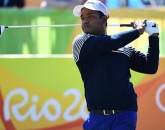 One of the best things about last year’s PGA Championship, apart from Asia celebrating Yang Yong-eun as its first major winner, was the sight of Tiger Woods trying to intimidate his Korean opponent. Given Tiger’s record, it’s obvious the man has a tonne of game, and not just of the technical variety. During that enthralling final round, Woods repeatedly tried to “crowd” Yang on the tee, and walked off at least two greens with Yang still to putt. Woods has used intimidation tactics before, and as the record shows his opponents don’t usually survive. At worse, they collapse; at best, they ignore it. What Yang did differently was to react positively to it, seeing it for what it was: an indication of a lack of confidence on the part of the aggressor.
One of the best things about last year’s PGA Championship, apart from Asia celebrating Yang Yong-eun as its first major winner, was the sight of Tiger Woods trying to intimidate his Korean opponent. Given Tiger’s record, it’s obvious the man has a tonne of game, and not just of the technical variety. During that enthralling final round, Woods repeatedly tried to “crowd” Yang on the tee, and walked off at least two greens with Yang still to putt. Woods has used intimidation tactics before, and as the record shows his opponents don’t usually survive. At worse, they collapse; at best, they ignore it. What Yang did differently was to react positively to it, seeing it for what it was: an indication of a lack of confidence on the part of the aggressor.
From the earliest days, it’s been clear that golf is as much a mental game as a physical one. We’ve all seen the phenom who can rule the world on the driving range but can’t win a match to save himself on the course. It was ever thus. In the days before Old and Young Tom Morris rose to prominence, Allan Robertson, perhaps the first-ever professional golfer, was hailed as “The Greatest Player Who Ever Lived” and was said to have never lost a match. That said, he was also alleged to have deliberately avoided matches that he could potentially lose.
Pages
Click here to see the published article.











